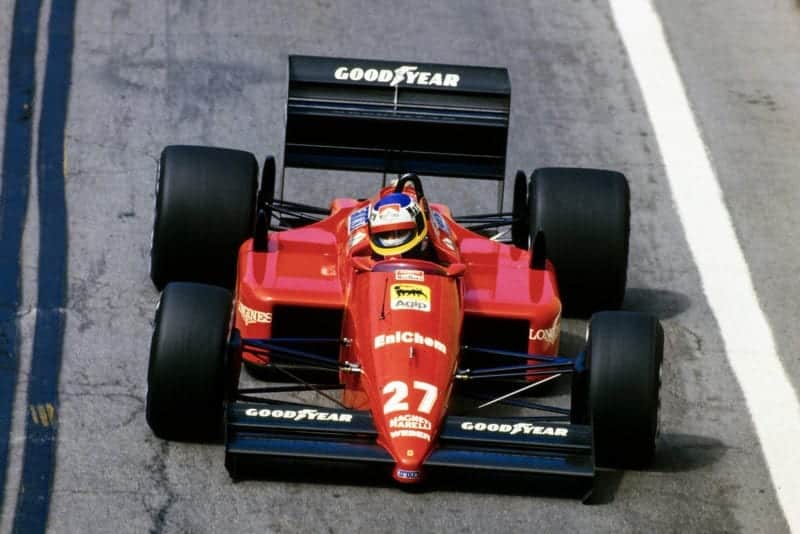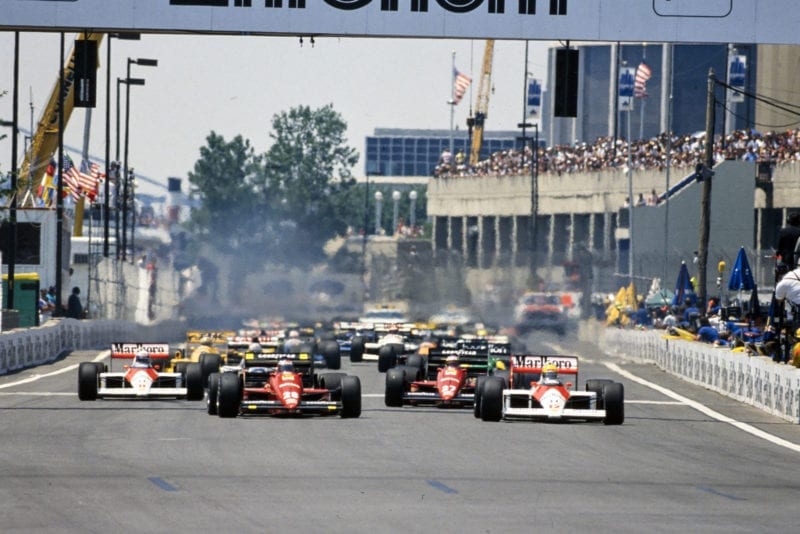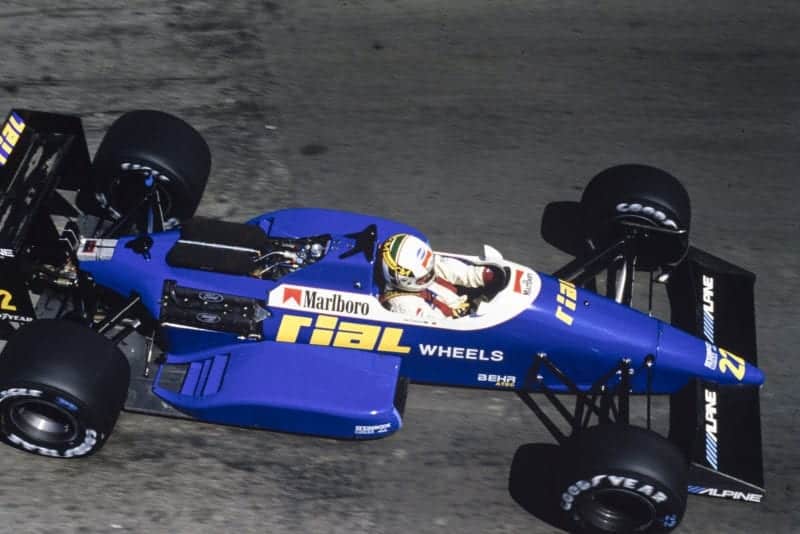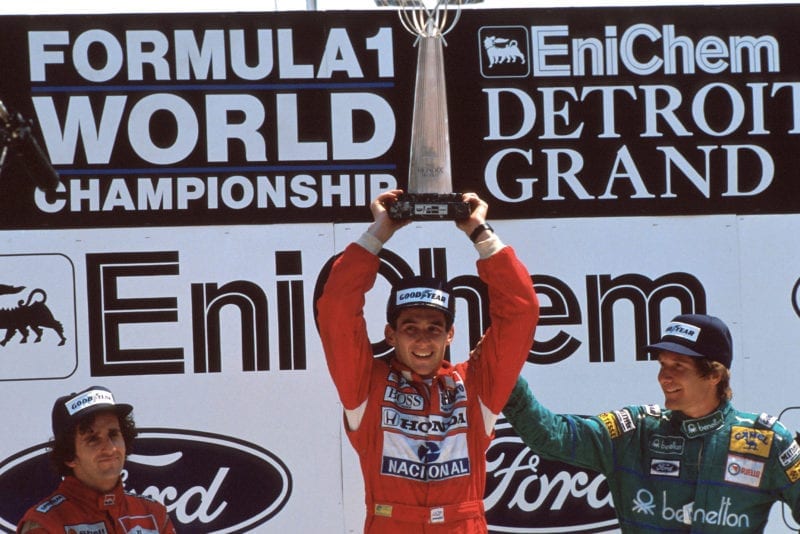1988 United States Grand Prix race report

Ayrton Senna made it win No 3 in Motor City
Motorsport Images
End of the road
Downtown, Detroit, June 19
When the idea of a Formula One race round the streets of Detroit was first mooted and a date fixed for 1982, a lot of people were very sceptical and at best viewed it as a one-off shot. But Chris Pook and the Long Beach people in California had shown that it was possible to race round the streets of an American city, lining the circuit with impenetrable concrete blocks and wire netting, and catching wayward cars in vast areas of old car tyres.
The United States Grand Prix round part of Detroit described as Downton has now been held successfully for seven years, but if all goes according to plan this year’s race was the last to be held on the city streets. It is proposed to build a permanent circuit on an island in the Detroit river, in the way the Canadians have built their circuit on the island in the St Lawrence river near Montreal. If this idea catches on we might see a London Grand Prix on the Isle of Dogs in the Thames!
The Detroit river island is called Belle Isle, reached by a five-lane bridge from the mainland or a 15-minute boat ride from Detroit Downtown river-front. Reception of the news the day before the seventh Downtown Grand Prix was mixed: drivers, mechanics and race-workers welcomed the idea, glad to see the back of the shambolic temporary arrangement of the present circuit, but public reaction was opposed, the feeling being that the party atmosphere that surrounds the present circuit would be missing. Nature lovers were loud in their complaints because the noise might frighten the herd of deer that lives on the island!
However, to the last of the Detroit street races. Once again it was all about Ayrton Senna, McLaren cars, turbocharged Honda engines and total domination by the McLaren International team. There is not much point in talking about the opposition, because it doesn’t exist.
With the two best drivers, in the two best cars, with the two best engines, controlled by the best team management, it would be silly if they didn’t finish first and second. It is the way the Daimler-Benz team dominated the scene in 1955 with Fangio and Moss; there are no mysteries, no secrets, no unfair advantage, everything that McLaren International has is the best.

Michele Alboreto qualified 3rd for Ferrari
Motorsport Images
Some journalists were saying that the McLaren domination is bad for the sport. Sport? Grand Prix racing stopped being a sport in 1907. When asked if he thought his domination was spoiling Formula One, Senna pointed out that he had spent two years trying to win races and thus become World Champion, only to be frustrated by unreliable Renault engines and unreliable Lotus cars. At last he had a car and engine combination in McLaren MP4/4 and Honda V6 turbo that was giving him the opportunity to go for the World Championship. If others could not keep up he was sorry, but it was not his problem.
The McLaren International “boss man” Ron Dennis was equally frank when asked why his drivers were not allowed to talk to the Press after qualifying, until the McLaren engineers had spent an hour or so discussing the results of qualifying. He said that they were in Detroit for the sole purpose of winning the race; that was their job, and they did it to the best of their ability. Six victories out of six races rather speaks for itself as regards their ability as a team. Talking to the Press had to be of secondary importance. For once I agree wholeheartedly with Mr Dennis.
Street racing is very unforgiving, as is practice and qualifying, and there were lots of spins, locked-up slides into escape roads, brushes with walls and nasty-looking crashes, but from it all there were only two injuries. Stefano Modena “ricked” his neck, and Ivan Capelli broke a bone in his left foot. A lot of cars were broken and bent, but none were totally lost, the rebuilding by the mechanics being an almost continuous operation. As soon as one team finished its rebuilding, another started!
Through it all Ayrton Senna was uncatchable, even by his team-mate Alain Prost, but the Saturday afternoon qualifying produced an unreal situation. The weather was very hot and on many corners the tarmac was breaking up. In the qualifying hour, if you didn’t go out quickly and set a good time you were in trouble. Senna and the two Ferrari drivers got their laps in early, but Prost missed out and when he tried again the track had deteriorated and he ended up fourth, Berger and Alboreto being between him and Senna.
A lot of people who obviously had not been paying attention thought that the starting grid represented a magnificent upsurge in the Ferrari challenge. It was no such thing, and in the race it took both Alain Prost a mere six laps to pass both Ferraris and take up position behind the flying Brazilian who had gone into the lead from the start. You hear a lot of talk about how it is impossible to overtake on the stop-and-go Detroit circuit, but it looked as though nobody had told Prost.
Once again the race as such was all over and Senna was perfection, as was his McLaren-Honda. Prost was not happy with his gearchange and once or twice we saw him skittering a bit wide on corners as he missed a change down. There was no way he was going to give Senna any trouble, even without gearchange problems, and the two cars reeled off the 63 laps (not 64 as the American television commentator kept saying), lapping everyone in the process. Both drivers stopped for a tyre change, but they had all the time in the world, and in the closing laps Senna slowed down so much that some of the slower cars he had lapped more than once were able to pass him and regain a lost lap.
Among the rest the Benettons were undoubtedly the best, and oddly enough both of them were indirectly responsible for the demise of a Ferrari.

Senna turns pole into the race lead
Motorsport Images
Both Nannini and Boutsen were well in the hunt for third place right from the start, hard on the heels of the Ferraris once Prost had got by them. On one slow corner Boutsen made light contact with Berger’s Ferrari, and a moment later the left rear tyre on the red car deflated, but whether it had been damaged by the Benetton was hard to say. Boutsen continued undisturbed but Berger came to rest at the far end of the circuit from the pits, the back end dragging along the road.
That was on lap seven and on lap nine Nannini ran into the back of Alboreto’s Ferrari on a slow right-angle corner. The Ferrari spun to a stop and the Benetton went on its way. After a long pit-stop Alboreto re-joined the race in next-to-last position, and though he climbed up from 22nd place to seventh place the rear suspension eventually broke and spun the Ferrari into retirement.
Nannini did not get anything like as far, as the collision had damaged the front suspension of the Benetton and it was out on lap 15.
Boutsen’s drive was another smooth and unruffled performance, like he had made in Canada, and the result was a very praise-worthy third place, one lap behind the McLarens and well ahead of all the surviving non-turbo cars. He couldn’t have done more, and no doubt the Ford hierarchy who were watching the race were well satisfied with their backing of Cosworth Engineering and the Benetton team. Certainly Mr Benetton himself was well pleased to see “The Colours of Benetton” being carried so strongly by the Witney-based team both in Canada and the United States of America.
The Judd-powered cars made no impression whatsoever, and had another wasted trip. Neither of the Williams cars lasted until half-distance, and even when they were running were not serious contenders for third place. Mansell had his car come to rest on his way round to the starting grid when all the driver to the rear wheels disappeared. Eddie Cheever gave him a lift back to the pits, and he took over the spare car in a great hurry and just made the grid. His race only lasted for 19 laps before the power unit died, and a few laps later the same thing happened to Riccardo Patrese’s engine.

Andrea de Cesaris scored a famous 4th for Rial
Motorsport Images
The March effort was halved during Saturday practice when Ivan Capelli crashed into the pit-wall while leaving the ess-bend chicane. The left front corner was destroyed, and the cheerful Italian driver broke a bone in his foot, spectating on race day from a pair of crutches. Mauricio Gugelmin ran nicely in mid-field during the opening stages of the race and was up to fifth place as others retired, only to succumb to engine trouble just after half-distance. All one can say about Arnoux and Johansson with the Judd-powered Ligiers is that they qualified for the starting grid.
The performance of the Honda-powered bright yellow Lotus cars must have made Colin Chapman weep in despair, up on high (or wherever he is). Satoru Nakajima failed to qualify and if Nelson Piquet’s car hadn’t been painted bright yellow he would have been missed altogether. As it was, he probably wished it had been a sombre black when he crashed into the unforgiving barriers and retired.
There was a fleeting glimpse of the reigning World Champion as Senna lapped him on lap 20, barely a third of the way through the race, which prompted the thought: “Wait a minute, they are both using Honda-turbo engines, how can Senna be lapping Piquet.” But he was.
For the British contingent in Detroit the Tyrrell team gave some pleasure, especially Jonathan Palmer, who collided with Larrauri’s EuroBrun on the opening lap and had to make a pit-stop for a new nose-cone, rejoining dead last. The doctor then got stuck in and drove his heart out to catch the tail-enders, work his way through them and climb to an eventual fifth place – a well-deserved result, even if he did have a quick spin on lap 30. New boy Julian Bailey had his first proper race and kept his end up well, but then spoilt it all by crashing into a wall on his last lap due to sheer exhaustion.
Among the smaller teams there was one significant change since Canada. This was in the Minardi team where Adrian Campos was stood down and Pierluigi Martini took the Spaniard’s place in car No 23. He more than justified the opportunity by bringing his Minardi-Cosworth DFZ home into sixth place. His team-mate Luis Perez Sala, who drivers very neatly and smoothly, was put out by gearbox trouble.
To regular Formula One followers, one of the most remarkable sights was to see Andrea de Cesaris finish in a strong fourth place with Gunther Schmid’s Rial-Cosworth DFZ. He hasn’t been nicknamed de Crasheris for nothing, and to see him keep the Rial off the walls and barriers for 62 laps was heartening, while the car itself, designed by Gustav Brunner, is a neat and tidy machine.
With the “big wheels” (apart from McLaren, of course) falling by the wayside, the Detroit race was a good opportunity for some of the smaller teams to gather up some of the FOCA money.
FOCA collects the total monies and pays it out on results, not on promises, so that the harder you try and the further you go, the more money you get. Payments are made at quarter-distance, half-distance, three-quarters distance and at the finish, so the Rial, Tyrrell and Minardi teams were able to watch the cash-register ringing up the numbers as well as collecting valuable World Championship points, which pay off next year in FOCA travel benefits.

Senna takes the podium plaudits
Motorsport Images
As the sun went down behind the glass monument called the “Ren-Cen” (a vulgar abbreviation for the Renaissance Centre), we bade farewell to Downtown Detroit and looked hopefully across the Detroit River to Belle Isle and 1989. DSJ
